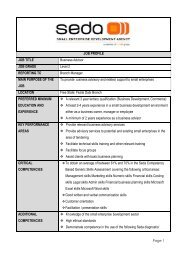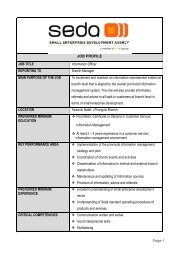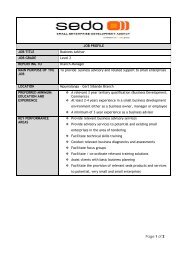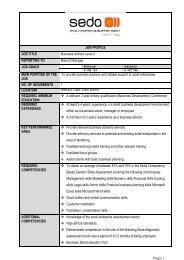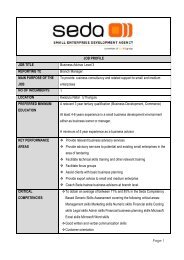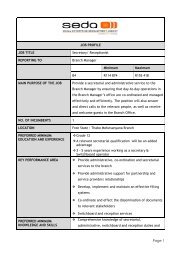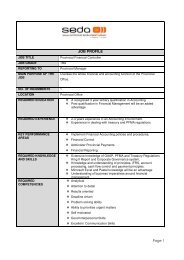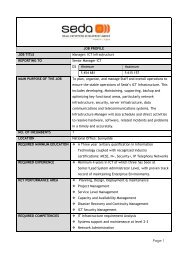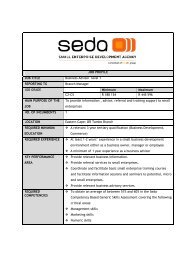Assessment of Cooperatives in the Poultry Industry - 2013.pdf - Seda
Assessment of Cooperatives in the Poultry Industry - 2013.pdf - Seda
Assessment of Cooperatives in the Poultry Industry - 2013.pdf - Seda
You also want an ePaper? Increase the reach of your titles
YUMPU automatically turns print PDFs into web optimized ePapers that Google loves.
Research Report: Address<strong>in</strong>g <strong>the</strong> Needs, Opportunities and Challenges <strong>of</strong> <strong>Cooperatives</strong><br />
and Collectively Owned Enterprises <strong>in</strong> <strong>the</strong> <strong>Poultry</strong> and Related Industries<br />
The need for f<strong>in</strong>ancial skills is strongly related to <strong>the</strong> <strong>in</strong>formation presented <strong>in</strong> this graph. Almost all<br />
<strong>the</strong> categories relate to a need for greater f<strong>in</strong>ancial management, cash flow problems or a lack <strong>of</strong><br />
project management skills. The ‘o<strong>the</strong>r’ category <strong>in</strong>cludes lack <strong>of</strong> trust <strong>in</strong> members regard<strong>in</strong>g f<strong>in</strong>ances<br />
and credit problems due to late repayment from customers. Both <strong>of</strong> <strong>the</strong>se two additional concerns<br />
could be lessened with improved systems <strong>of</strong> f<strong>in</strong>ancial management and with management <strong>of</strong><br />
customers.<br />
A closer look at where cooperatives are struggl<strong>in</strong>g with expenses creates an improved picture on <strong>the</strong><br />
causes <strong>of</strong> f<strong>in</strong>ancial problems. Table 4-4 below <strong>in</strong>dicates <strong>the</strong> percentage <strong>of</strong> responses received for<br />
each <strong>of</strong> <strong>the</strong> below categories. It is clear from <strong>the</strong> table that <strong>the</strong> overwhelm<strong>in</strong>g majority <strong>of</strong><br />
cooperatives stated that feed and transport have <strong>the</strong> greatest impact on <strong>the</strong>ir bus<strong>in</strong>ess.<br />
Table 4-4: Expenses with <strong>the</strong> greatest impact on cooperatives<br />
Expense Item % Incidence Expense Item % Incidence<br />
Salaries and wages 2% Transport 39%<br />
Feed 50% Advertis<strong>in</strong>g and Market<strong>in</strong>g 0%<br />
Adm<strong>in</strong>istration Costs 4% Security 0%<br />
Electricity 2% Medic<strong>in</strong>e 2%<br />
Source: Urban-Econ Survey, 2013<br />
The high number <strong>of</strong> cooperatives who reported feed as a major factor <strong>in</strong> <strong>the</strong>ir expenses is <strong>in</strong>dicative<br />
<strong>of</strong> <strong>the</strong> large proportion <strong>of</strong> this cost contribut<strong>in</strong>g toward expenditure. In his study on <strong>the</strong> value cha<strong>in</strong><br />
for farmers <strong>in</strong> <strong>the</strong> broiler <strong>in</strong>dustry, Louw (2011) argues that feed generally contributes to around<br />
70% <strong>of</strong> <strong>the</strong> total costs <strong>of</strong> broiler production. In Section 4.1.2.4: (Customers and Suppliers) below<br />
more background <strong>in</strong>to this challenge is given. The high proportion <strong>of</strong> feed costs to total costs is a<br />
strong factor <strong>in</strong>fluenc<strong>in</strong>g <strong>the</strong> competitiveness <strong>of</strong> South African poultry <strong>in</strong> <strong>the</strong> <strong>in</strong>ternational market.<br />
Countries such as Brazil are able to source feed at lower costs<br />
than farmers <strong>in</strong> South Africa and this allows <strong>the</strong>m to produce<br />
poultry at a lower cost. The price <strong>of</strong> gra<strong>in</strong> <strong>in</strong> South Africa is tied<br />
to <strong>in</strong>ternational prices, while <strong>in</strong> Brazil feed prices can be<br />
determ<strong>in</strong>ed <strong>in</strong>ternally due to <strong>the</strong> high volumes <strong>of</strong> production.<br />
It has been <strong>in</strong>dicated that cooperatives struggle to transport <strong>the</strong>ir goods to <strong>the</strong> market, this is <strong>in</strong> part<br />
due to a lack <strong>of</strong> transport. Additionally, when asked about <strong>the</strong>ir location, many cooperatives placed<br />
<strong>the</strong>mselves as equidistant between two larger towns. This would mean that if <strong>the</strong> rural market <strong>in</strong><br />
which <strong>the</strong>y live is saturated, <strong>the</strong>y will have to travel approximately 100 km or fur<strong>the</strong>r to deliver <strong>the</strong>ir<br />
products. While this is not <strong>the</strong> case for all cooperatives surveyed, it may assist <strong>in</strong> understand<strong>in</strong>g <strong>the</strong><br />
high percentage <strong>of</strong> transport concerns. Ano<strong>the</strong>r factor <strong>in</strong> this regard may be <strong>the</strong> distance to an<br />
abattoir where cooperatives provide live birds to an abattoir <strong>in</strong>stead <strong>of</strong> sell<strong>in</strong>g to shops or<br />
community members.<br />
52 | P a g e U r b a n - E c o n : D e v e l o p m e n t E c o n o m i s t s<br />
Feed costs account for more<br />
than 70% <strong>of</strong> <strong>the</strong> total costs<br />
<strong>of</strong> broiler production



